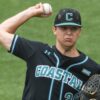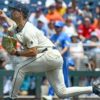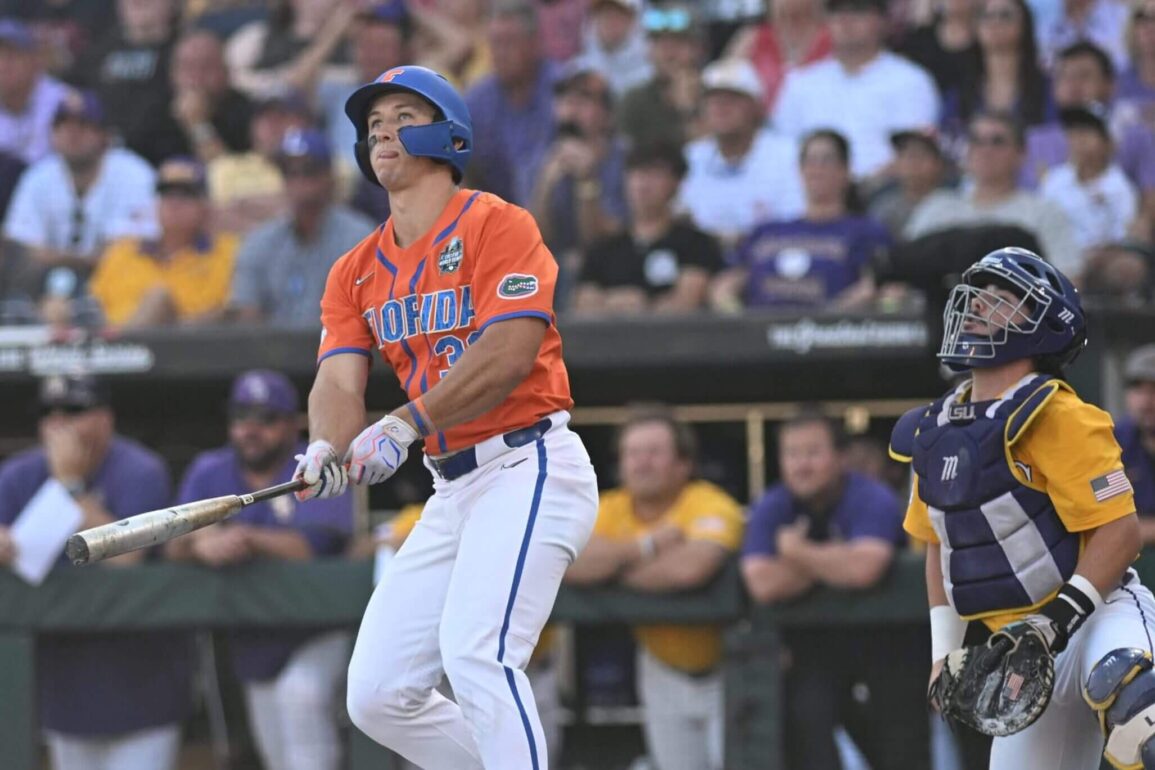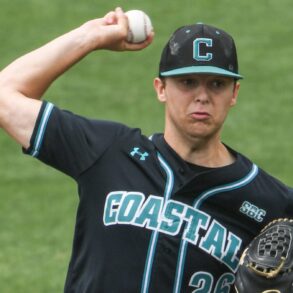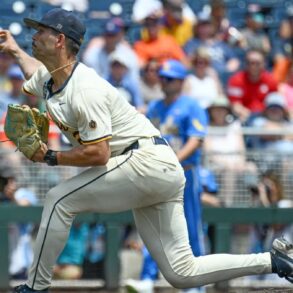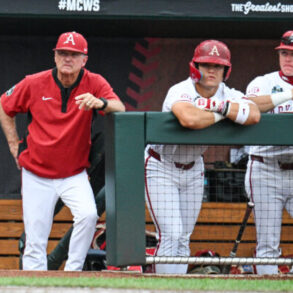OMAHA, Neb. — The college baseball world has made its annual pilgrimage to Charles Schwab Field for the 75th College World Series. It’s a diverse field with six different conferences (plus one independent) represented — a refreshing change after last year’s CWS included four teams from both the ACC and SEC.
Advertisement
I asked some people who cover the sport for their thoughts on the state of the game, the best players they have ever seen, the best rivalry in the sport and the best game they have witnessed.
The panel:
- Chris Burke, ESPN
- Mike Ferrin, ESPN/Sirius XM
- Aaron Fitt, D1 Baseball
- Kyle Peterson, ESPN
- Mike Rooney, ESPN
Best position player you have seen in college baseball?
Burke: I’m going to say Wyatt Langford. I thought the two years (2022-23) he put together at Florida, … he was almost flawless in the outfield. He ran the bases as hard as anybody I ever covered, especially for a superstar. And you felt like he was going to hit an extra-base hit every at-bat. So I’ll just go in the era that I’ve been covering the sport.
(Vanderbilt’s) Dansby (Swanson) was fantastic. The game wasn’t quite as offensive when he played. There’s a little recency bias there (with picking Langford). Alex Bregman (LSU) was more spectacular to me on defense than he was on offense. Now he’s become a Hall of Fame hitter.
And then from my playing career, I would say probably Mark Teixeira (Georgia Tech). Mark Teixeira was probably the most gifted college player I was ever on a field with.
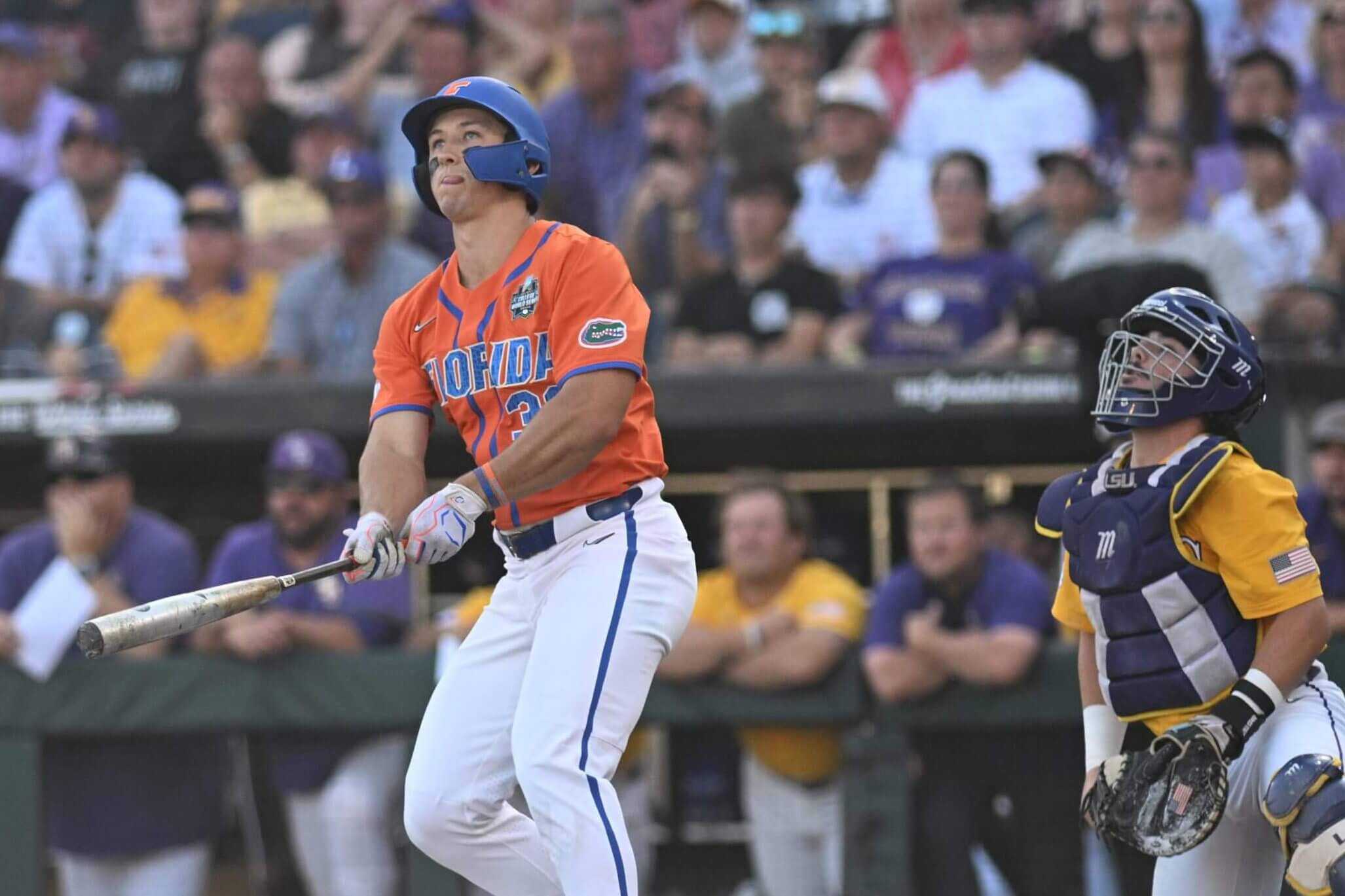
Wyatt Langford had a career 1.217 OPS at Florida. (Steven Branscombe / Imagn Images)
Ferrin: You know who was great? It was Trea Turner at NC State. There’s a good story here. They lost to UCLA (in Omaha) the year UCLA won the national championship (2013), and one of the things that (Turner) did postgame was explain exactly how Nick Vander Tuig, who was the Saturday starter for UCLA, was able to get guys out, because he was able to use his fastball at the top of the zone. He had one of those fastballs that had ride on it before we had the data to back it up, even though it was 92 mph.
Somebody relayed that to John Savage, the UCLA coach, in the press conference, and Savage’s jaw hit the table, and he was like, “Man, I thought that guy was good. I didn’t realize he had that kind of baseball IQ. That guy’s unbelievable.”
Advertisement
And Savage went on for, like, 45 seconds talking about how unique a player Trea Turner was, because in addition to having all of these incredible skills, he had this innate ability to understand the game. So that’s one that really stands out to me, even though he probably isn’t, like, the best of this era. But man, he had it at that moment. As a sophomore.
Fitt: I was living in Southern California for three years during the same three years that Kris Bryant was at San Diego, and just the fact that the guy hit more home runs as a junior (31 in 2013) than about two-thirds of the college baseball teams hit — he was a monster among boys or whatever you want to say. It felt like Babe Ruth, where he’s hitting more home runs than a bunch of teams hit. And he could do a lot of stuff. You could move him around a little bit. He was never known as a defensive whiz, but he played solid enough third baseman, right field, wherever, and he could run better than you thought. The power was just special. He got better and better year over year. Great personality, magnetic. And I think just because of the era that he dominated in and the degree to which he dominated, that would have to be my answer.
Peterson: Mark Kotsay (Fullerton State). I played against him (while at Stanford), so maybe that’s part of it. … We played him Game 1 of the College World Series (in 1995). Well, first of all, the first college game I ever played in was at Fullerton. And I knew who he was, but I didn’t know a lot about him. And about three pitches later, he had a line drive right off my quad that I could feel the entire year.
And then they beat us in Game 1 of the College World Series that year, and Kotsay had a couple hits and then trotted in from center field to close the game in the ninth inning. He was, for me, like the ultimate college baseball player. And obviously he had a great big-league career, and now he’s managing the big leagues. But that’s the best one for me.
Rooney: I want to say Dustin Pedroia, but I coached him (at Arizona State, 2002-04) and I saw him every day for three years. He was the national defensive player of the year and the only MVP of Arizona State baseball for three consecutive years. Not even Barry Bonds did that.
Advertisement
I want to give you two, since I coached Pedroia. I’m going to do this: I’m going to say Chris Burke (at Tennessee). He almost hit .500, 50 stolen bases, 20-plus home runs (.435, 49 stolen bases, 20 home runs in 2001) and ran their defense from the middle of the field. Like, just a do-everything player.
Who’s the best college pitcher you have ever seen?
Burke: Paul Skenes, end of statement. He had the aura of nobody else. The only pitcher I’ve ever been around that had his aura was Roger Clemens. And I was fortunate to play with him for parts of three seasons (in the major leagues). But there was just something very unique when you were around Paul Skenes. And then the pitchability, combined with just the pure stuff, was a combination that to me was like nothing I’d ever seen in a college game.
Ferrin: It’s either Skenes or (Stephen) Strasburg. Strasburg was incredible, too, but what Skenes was able to do … he didn’t have the best slider, he didn’t have the best fastball — (LSU teammate) Ty Floyd’s fastball, metrically, was better — it was just the fact that he knew how to pitch, his competitiveness, the way he continually improved, and the way that he carried himself. That guy was unreal. That’s one of the great college seasons of our time.
Fitt: So I would have said Stephen Strasburg for a long time until Skenes. But everyone’s gonna say Skenes, so I’m gonna give you Strasburg. He was insane. Even the first time I ever saw him, it was his freshman year (2007), and it was on a random day, it’s like a Tuesday game, I think. And people were kind of whispering, “You gotta see this kid. He is so big, he blocks out the sun.” It’s just a ridiculous, explosive fastball coming at you. Didn’t hear a lot about this kid coming out of high school. He was overweight and didn’t really work hard enough, and then he got to San Diego State and something clicked for him. The coaching staff, Tony Gwynn and (pitching coach) Rusty Filter, deserve a lot of credit, but so does Steven, of course.
By the time he was a junior, he was just a monster. It’s 96 to 100 with command in an era where you didn’t even see that kind of velocity very much. Ridiculous breaking ball with command. Plus-change up with command. And the ability to miss bats and throw quality stuff that was just so much better than everybody else’s stuff at that time. The stuff he did was absurd.
Peterson: Skenes. Before that, I probably would have said (Stephen) Strasburg, because I saw Strasburg in college when he was at San Diego State. But Skenes was as good as stuff as you would ever want to see, but then the control of Jamie Moyer or (Greg) Maddux or somebody like that. And I’ve never, in the college game, I’ve never seen the combination of as good a stuff as anybody in the country and as good a control as anybody in the country. And Skenes had that, and obviously, it continues to work out fairly well for him.
Rooney: Best one I coached against was Mark Prior (at USC). Best one I’ve seen is Paul Skenes. With Prior, it was Greg Maddux command with the best fastball in college baseball at the time. And Skenes, just like a ferocious competitor, generational arm talent.
Advertisement
Name a player who ended up being a much better pro than you thought
Burke: This is way back from my first year, second year broadcasting. It was Kyle Farmer, shortstop at Georgia (2010-13). Ended up being a really good major league shortstop for the Reds. I think he was an (eighth-rounder). I think he was a senior sign, and you look up, and he’s had a really nice career.
Ferrin: Pete Alonso (Florida, 2014-16). I thought he was sort of an Ivan Melendez (Texas) type, a big power guy, then he was going to get to pro ball and he was going to really struggle. What I didn’t understand was the guy really knew how to hit. I think even now, he still doesn’t get appreciated for how good of a hitter he is. He knows how to use the middle of the field. He knows the situations that call for him to drive in a run. That wasn’t readily apparent to me when he was at Florida.
He also wasn’t the biggest star on those teams. He was a little bit further down on the list. And he wasn’t the most dynamic presence. I had no idea he was going to be the player he is now. Testament to his work ethic and his intelligence. And he’s also got way better as a defender.
Fitt: I’ll just go back to my first year at Baseball America. Justin Turner was a nice kind of rugrat grinder from Cal State Fullerton (2003-06). “Red” Turner. He was a seventh-round pick or something, a senior sign. Never really hit for power. He was a great college player. I loved him as a college player. He would take a lot of walks. But I didn’t ever think that guy was gonna go be a plus-home run hitter in the major leagues and go to a bunch of All-Star games and be a vital part of championship teams. Especially after he got released. Who was it, the Mets, who released him? That’s a cool story. That guy just never struck me as anyone who would hit for power and be an impact big leaguer.
Peterson: Brandon Woodruff (Mississippi State, 2012-14) would be on that list. He’s had a hell of a run from a mound standpoint.
I played with a dude named Eric Bruntlett (Stanford, 1997-2000) that played in the big leagues for seven or eight years and won a ring or two, and I don’t know that he would have been the guy off our team that we would have picked to play the longest. But he played longer than anybody.
I can tell you this: I saw Aaron Judge (Fresno State, 2011-13) in the home run derby here, the college home run derby, and nobody would have thought … you thought the guy’s physical and talented and everything else, but he could go down as one of the greatest hitters ever by the time he gets done. So Judge is probably on that list. Not to say that people didn’t think he’d be good, but I don’t think anybody could have thought he’d be this good.
Advertisement
Rooney: Steven Kwan. He was on that 2018 Oregon State that won it all. Oregon State had four first-round picks. They had Cadyn Grenier, they had Nick Madrigal, they had Adley Rutschman, and they had Trevor Larnach, but they also had Steven Kwan (who was drafted in the fifth round). And I bet you Steven Kwan’s WAR this year, I’d have to look up Rutschman’s, but I bet you Steven Kwan’s WAR is better than any of those guys. (Note: Kwan’s WAR is 2.8. Rutschman’s is 1.1.)
What is the best rivalry in college baseball right now?
Burke: I would say probably Tennessee and LSU. Past two defending national champions, two coaching staffs, two athletic departments, two fan bases that are all in it. I think Arkansas, with that group, would be right there in it. Texas A&M is pretty good, too. I know I gave you a lot, but it feels like it’s hard to (pick one). Tennessee-Vanderbilt is pretty good, too. It feels like there’s a lot of budding SEC rivalries just because of the all-in nature. There are way more teams that are all-in.
Ferrin: The SEC versus the SEC. I think any time that you have those power conference teams — I hate to cop out with SEC versus SEC — but I think those are all pretty good. I think Texas A&M versus Texas right now is a little bit spicier because of (Jim Schlossnagle) leaving (Texas A&M for Texas) last year, so I think that’s a good one. You know, I think those are ones that really stand out to me, in that conference, just because the places are all packed and most of them are a little bit bigger than the other places. It just creates more energy that you expect out of a rivalry.
Fitt: I think you have to say Tennessee-Arkansas at the moment. It’s kind of the one that feels like it’s got the most juice. LSU-Arkansas also has a lot of juice. Those SEC deals, they just feel a little bit different. Traditionally, I still think Clemson-South Carolina, when those (teams) are both good, it’s awesome. But obviously, those programs are not where they were in 2010, when they were both in Omaha. That was something special. But at this particular stage, I think it’s shifted toward those SEC rivalries.
Peterson: Ole Miss-Mississippi State is always going to be there, just because of being within the state. The whole Florida component between Florida, Florida State, Miami is interesting, but they do it differently. (Florida) plays Miami on the weekend every year and they play Florida State in three midweek games, so that’s a little bit different. Tennessee-Arkansas has turned into a really good rivalry. I don’t know that there’s one.
Rooney: I would say Tennessee and Vanderbilt.
What is the college game you’ve ever seen?
Burke: I would say the Skenes vs. Lowder (LSU vs. Wake Forest in the 2023 CWS). Ends in a walk-off home run by superstar player Tommy White. Two major league All-Stars on the mound. And it was a night game. I think we had Roger Clemens on the broadcast, like, early in the broadcast. It was just a night you’ll never forget.
Advertisement
And there were a couple of legendary plays — Tre Morgan threw somebody off the plate on just an incredible defensive play. You know, there are just so many flash points within the game. But more than anything, you’re like, “We’re watching two major league All-Stars pitching in college.” And I know Lowder hasn’t made an All-Star team yet, but he sure feels like he’s going to. And Skenes is on his way to No. 2.
Ferrin: Skenes-Lowder, without a doubt. It’s so rare to see a pitching matchup that actually lives up to the expectations like that. And that game had everything. And then the coolest moment … so when Tommy White hits the walk-off homer and celebrates with his team, and Cam Minacci, who’s the pitcher for Wake, and Bennett Lee, who’s the catcher for Wake, were friends of his growing up. And what did he do? He went over to console them afterwards. That’s like one of the great moments of sportsmanship in NCAA history, and I hope everybody always remembers that. Because in the end, these guys love competing against each other, but because they’ve all grown up playing together, they all know each other, and a lot of times they’re friends, and those relationships matter more than the wins and losses. I thought that was really cool.
Fitt: There are only two answers here. It’s the Skenes-Lowder game or the last game of Rosenblatt (in 2010). It was awesome. The fact that the last game of that ballpark ended on a walk-off in the 10th inning, two great teams, it was the start of that South Carolina dynasty. You got Whit Merrifield and Scott Wingo in the middle of it. You got Trevor Bauer out of the bullpen warming up (for UCLA). Incredible game and just the whole feeling there. It was so bittersweet. All of us were heartbroken about leaving that ballpark, and it was just awesome that they could send it out with a thriller like that.
Peterson: The Wake Forest-LSU game a couple years ago was as good as I’ve ever seen here. I’ll never forget the last game at Rosenblatt when it was South Carolina-UCLA and (Whit) Merrifield got the hit down the right-field line. I think some of that was just because it was the last game at Rosenblatt, maybe. But yeah, the LSU-Wake, really that entire tournament. There were some games that year that were as good as we’ve ever seen here.
Rooney: I think everyone’s going to give you Skenes vs. Lowder. So I’m going to give you a different one. I got to call Kumar Rocker’s 19-strikeout no-hitter in 2019. People forget this, but Duke had already won Game 1 of that Super Regional. That Vandy team was one loss from their season ending, and Kumar Rocker, a true freshman, steps up and throws a historic game to completely flip the momentum of that Super Regional.
What is the best part of college baseball in 2025?
Burke: I think the exposure. The spotlight is much brighter than it’s ever been. Both with the digital networks, the conference network and then ESPN’s commitment to the sport. Combine that with a social media presence that all these teams do a really good job of, I just feel like these players are on a much bigger stage than they’ve ever been on.
Ferrin: I think it’s the atmosphere. To me, it’s these 3-, 4-, 6,000-seat stadiums that are on campuses in places that they really care about college baseball — which is growing too — and that you’re filling them with fans who have the same energy that you have for college basketball. Even in places like Manhattan, Kansas, like where they sell out. Being able to create those environments is really rewarding for the sport because you can’t not want to be a part of that if you get to experience it.
Advertisement
Fitt: I like the product, personally, better than Major League Baseball because of, and it’s gonna sound cliche, but it’s just the energy. It’s the energy of it. Especially the postseason, the on-campus sites. I don’t think there’s anything like it when you’ve got the home Regionals on-site and the Super Regionals. It’s just electrifying, and I think the drama, that part of the product, really holds up. I love the format of college baseball, all the way through the weekend series structure. I like the fact that it’s not 162 games. I think the season makes a lot of sense. It’s drawing in a lot more fans than it used to for a good reason. It’s not as polished a product as Major League Baseball on the field, obviously. That’s part of the fun of it. It leads to some unpredictability, and I think it’s just compelling theater.
Peterson: I love it because of the fan bases, and it’s college (athletics). When you go to some of these environments, Arkansas, LSU, Ole Miss, Mississippi State, Florida State, whatever — you can name a bunch of them, it’s like college athletics fans. And I just think there’s something really cool about that. From a player standpoint, I just think it would be really cool to play in those environments. So, for me, it’s the environments that these kids are surrounded by.
The level of play and everything else continues to get better, and we’ve seen that based on the draft. The draft is more college-based now than it’s ever been because Major League Baseball realizes that this is a really good way to develop players. So I’d say both of those. I love going to college baseball stadiums, environments, towns. That’s my happy place.
Rooney: I would say this (pointing to the field). We have an Omaha field that represents seven different conferences or non-conferences, depending on how we want to describe Oregon State. We knew we didn’t really have a super team like we’ve had the last four years, but this year, for this to play out the way it did, to go from a year where you only had two leagues in Omaha, to have seven different affiliations represented, is super cool and very encouraging.
What is the sport’s biggest issue?
Burke: Probably the roster uncertainty. How many spots are going to be available? How is that going to limit opportunities? I think it’s interesting. A decade ago, we were all clamoring for more scholarships, and now with NIL, the scholarship delta has kind of been fixed. In one regard, you want to be thankful that kids are, for the most part, going to have a lot more aid, if not full aid. But if it goes from 40 to 34 (roster spots), you’re talking about six players per 310 teams. That’s a lot of players that aren’t going to get opportunities to play Division I baseball. So I think figuring out what that is and what the new normal is going to be is probably what I would consider to be the biggest issue.
Ferrin: I want there to be more consistent parameters from the committee before the season starts on what’s gonna constitute the decisive factors (to get into the NCAA Tournament). So, like every year, we see a little bit of variation, but we never find out until after the fact that this was the year that nonconference strength of schedule mattered, or this was this, this was that. So I think that there’s something that can be done to try and better codify or balance out, or give coaches at least an idea of what’s gonna matter, especially since they’re having to schedule a couple of years out. I think that’s one that really stands out to me as being important, is that you wanna make sure that everybody is on even footing, at least in terms of what they understand.
Fitt: I think it’s just the issues facing college sports writ large. Where are we headed with NIL, the revenue-sharing stuff? Are we going to have too much of a gap between the haves and have-nots, when you’ve got schools funding 34 full scholarships and others are still down there at 11.7 or whatever? I think it’s going to be challenging to navigate.
Advertisement
There’s obviously a lot of upside potential for the sport, considering how long we were stuck at 11.7 and all we wanted was a few more scholarships, right? And now, all of a sudden, it’s just this whole new world right in front of us, and there are gonna be a lot of programs left behind. And I think the depth of college baseball is an important part of the sport. It’s nice that guys can have the experience of playing college baseball at 300-and-something schools.
You talk to the coaches at Central Connecticut State, and they go down to a big venue for a Regional at Georgia or Arkansas or whatever and just to see those guys soak in that experience, it’s magic. It’s part of what makes this sport special, and if we wind up in a situation where it’s just two big mega conferences and everybody else is just left behind, I think we’ll really lose an important part of the soul of college baseball.
Peterson: I would just say money in general. I don’t think anybody knows yet what this House settlement is going to be, and, ultimately, if that’s detrimental to the game at all. So I think the biggest challenge or potential issue right now is … the first thing is everybody’s got to know the rules. They don’t know them yet. So if the rules are what it sounds like they will be, they’ll continue to be a pretty significant financial gap. But that’s also the reality of the world.
So that would be my biggest concern, is whether or not that financial gap between those that can afford it and those that can’t creates way too many haves and way too many have-nots. But I think the field this year would indicate that that may not be the case.
Rooney: I would say our biggest issue is rosters. We have an unlimited fall roster, but then we’ll have this 34-man roster on Dec. 1 as part of the (House) settlement. And I think that both concepts are flawed, and somewhere in the middle would be a much better answer. So I’d say roster management is the biggest issue.
(Photos of Paul Skenes, Mark Kotsay: Scott Clause / USA Today Network via Imagn Images, Andy Lyons / Getty Images)
This post was originally published on this site be sure to check out more of their content.


